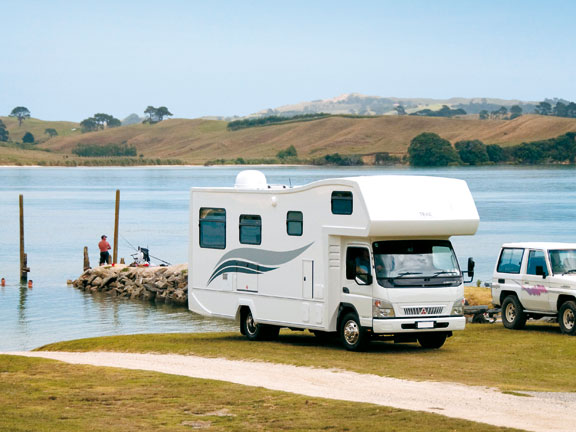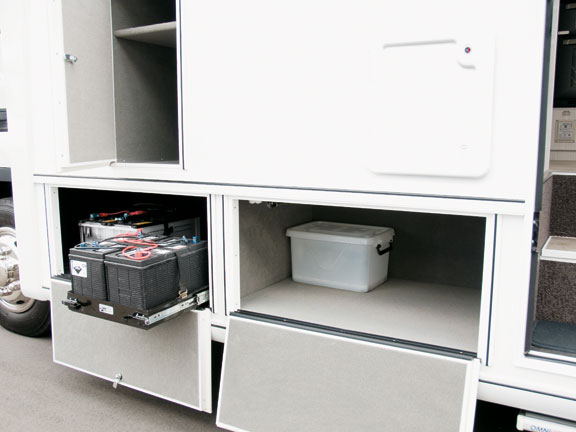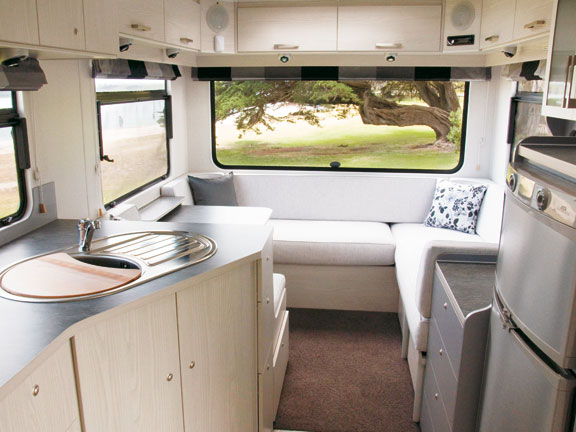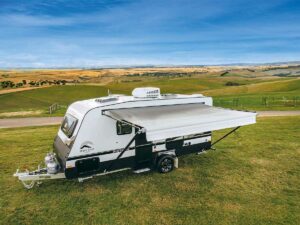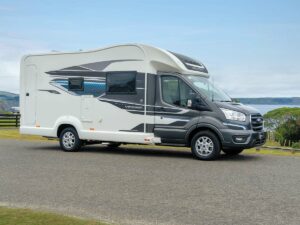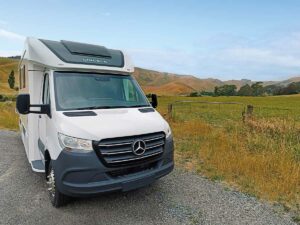Specifications
Aware that the Trail-lite motorhome interior had evolved and improved but the bodywork had been in production virtually unchanged since the early 1990s, the company began investigating new materials and production techniques that would allow it to upgrade its product and produce it more efficiently.
The new Trail-lite motorhome is more than just a new body shape. Beneath the new bodywork lies a whole new build system that is a complete departure from the construction methods used previously.
The traditional aluminium cladding over structural wooden frames method is replaced with a sandwich construction wall panel system. The new exterior cladding, the insulation panels, the glues and the vacuum pump manufacturing process have all been introduced from suppliers in Europe and the UK. These suppliers have provided manufacturing advice on how to use the new products, enabling Trail-lite’s experienced production team to produce a reliable and enduring end product.
John Nelson, the factory manager, positions the insulation panels that provide the stiffness to the wall panels onto the Alufibre exterior cladding panel that lies on the production table. The Alufibre cladding is manufactured in the Netherlands and arrives in crated coils, pre-finished in either white or silver. John, who has been with Trail-lite for over 20 years, explains the process.
“Because the insulation material is not suitable to fasten into, we place wooden inserts at strategic points in place of the insulation panels so that later on, when the furniture is fastened inside the body, there is a solid material inside the wall panel to screw into. The wooden inserts are necessary for this purpose but they don’t contribute to the strength of the wall panel.
“Once all the insulation and wooden inserts are in place and liberally coated with adhesive, the interior panel is placed over them. The wall panel is then squeezed together and left while the adhesive ‘cures’.
“The ‘squeeze’ process is accomplished using the power of vacuum rather than using a press. A sophisticated plastic ‘blanket’ is taped down to the production table, enveloping the wall panel. The powerful vacuum pump extracts the air from the blanketed enclosure and the ensuing vacuum pressure evenly compresses the wall panel components, ensuring all internal surfaces are bonded together. This lamination process produces a wall panel that is light but exceptionally stiff,” says John.
Trail-lite carried out tests on various combinations of adhesive and insulation material before settling on the combination that produced the optimum wall panel for its purposes.
Peter Newman, who has worked at Trail-lite for over 30 years and has owned the business since 1980, remarks, “I was pleasantly surprised how much quieter and nicer to drive the new model is. I think this is due to the body being much stiffer and the cladding being continuously glued, which eliminates panel drumming noises.”
Trail-lite chose Alufibre cladding material because it offers a high-gloss, easily cleaned, fade-resistant surface, free of bumps and ripples. Alufibre consists of pre-coated aluminium sheet bonded onto fibreglass sheet. This bonded sheet is almost exactly the same weight and thickness as the aluminium cladding previously used by Trail-lite and also offers better resistance against denting than plain aluminium.
There are other significant changes in the way Trail-lite has constructed its new 2009 model. The rear section and the Luton peak are now manufactured in fibreglass – a new departure for Trail-lite.
The rear section of the body is made up from four separate mouldings; the main rear facing panel, the locker lid and the two full-length corner mouldings.
The Luton peak consists of a top and bottom moulding.
“This was done,” says Shaun Newman, general manager, “so we could make different bottom mouldings to suit different vehicle’s cabs. We plan to offer the new model on a variety of vehicles, including Isuzu and Mitsubishi cab/chassis, as well as Mercedes-Benz, VW and Iveco.
“There are also two different Luton peak top mouldings. The higher profile provides ample headroom when sitting up in bed. The lower one is used where overall height is an issue or when the space over the cab is just used for storage.”
The motorhome roof is constructed once the walls and rear panel are in position. It is built using traditional methods, with a skin of Alufibre bonded to wooden roof rafters, with insulation between the rafters. The important ‘wall-to-roof’ bond is reinforced with a full-length aluminium extrusion that provides a stable bed for the water-sealing compound. The roof beams are higher in the centre so that water is shed over the sides to reduce of water ponding and subsequent leaks.
So what benefits does the body construction offer to owners?
"I would say the new body is much stronger and stiffer so it will be quieter and more durable over the long-term. The exterior cladding is more hardwearing and easy to clean, and will be easier to repair should you have an accident. On top of all that, it looks great, says Shaun”
While the colour scheme and layout are different from the previous Trail-lite we reviewed, the style of the fit-out has not altered greatly.
On the model reviewed, the high profile Luton, incorporating a large ‘Heki’ roof hatch, accommodates a fore and aft queen size double bed with separate access stairs to each side. A small cabinet provides room for bedside essentials for each occupant, as well as a place for your morning ‘cuppa’. There are ‘his and hers’ wardrobes beneath each stairway.
Behind the driving cab are the separate toilet and shower compartments, which face each other across the central access way. By opening the doors to both compartments simultaneously so they overlap, it is possible to screen off the area, creating a changing room.
The sizeable (2m plus) kitchen bench provides ample room, and the curve in the bench top provides a small ‘refuge alcove’ for the cook. There are heaps of storage places.
The rear lounge is L-shaped and incorporates a dinette table for two.
Opposite the kitchen bench, the cabinetry contained recesses for the 176-litre three-way fridge/freezer, microwave and LCD TV, and a glass-doored cupboard for a variety of beverage glasses. There are four large external lockers with room for tables and chairs, BBQs and golf clubs.
The elements that have made Trail-lite popular in the past – plenty of room, plenty of light, excellent storage, individual layout choice and quality build, to name a few – are all evident in the new model. The new components assembled using the new manufacturing techniques present the traditional Trail-lite appearance in a modern setting.
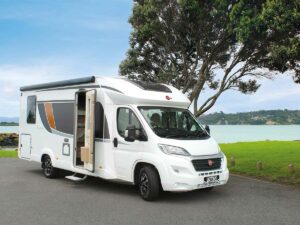
Review: Bürstner Lyseo IT744 Harmony Line
An elegant experience inside and out, the Bürstner Lyseo IT744 makes the most of its dimensions.


